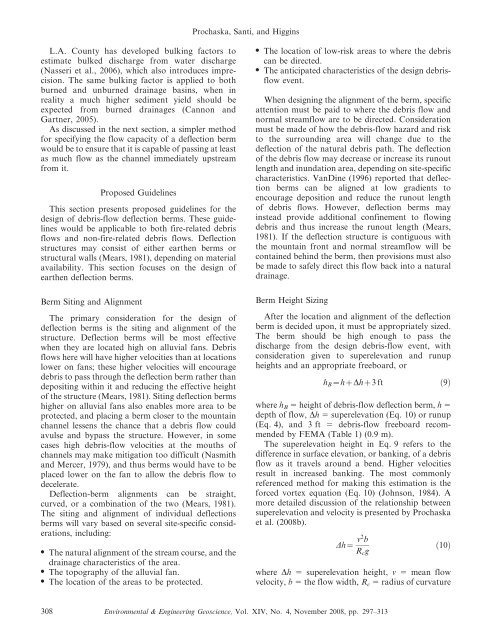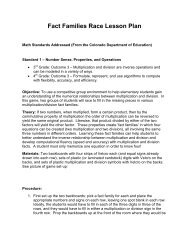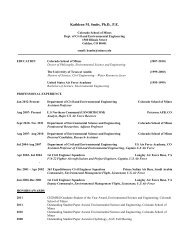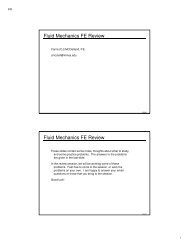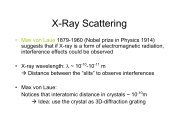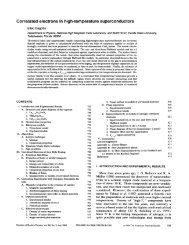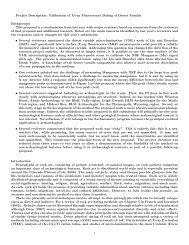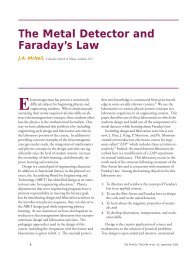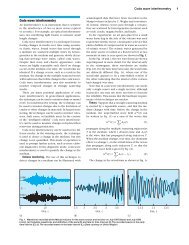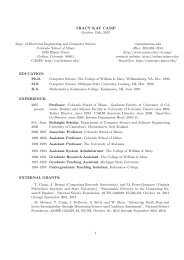Debris Basin and Deflection Berm Design for Fire-Related Debris ...
Debris Basin and Deflection Berm Design for Fire-Related Debris ...
Debris Basin and Deflection Berm Design for Fire-Related Debris ...
Create successful ePaper yourself
Turn your PDF publications into a flip-book with our unique Google optimized e-Paper software.
Prochaska, Santi, <strong>and</strong> Higgins<br />
L.A. County has developed bulking factors to<br />
estimate bulked discharge from water discharge<br />
(Nasseri et al., 2006), which also introduces imprecision.<br />
The same bulking factor is applied to both<br />
burned <strong>and</strong> unburned drainage basins, when in<br />
reality a much higher sediment yield should be<br />
expected from burned drainages (Cannon <strong>and</strong><br />
Gartner, 2005).<br />
As discussed in the next section, a simpler method<br />
<strong>for</strong> specifying the flow capacity of a deflection berm<br />
would be to ensure that it is capable of passing at least<br />
as much flow as the channel immediately upstream<br />
from it.<br />
Proposed Guidelines<br />
This section presents proposed guidelines <strong>for</strong> the<br />
design of debris-flow deflection berms. These guidelines<br />
would be applicable to both fire-related debris<br />
flows <strong>and</strong> non-fire-related debris flows. <strong>Deflection</strong><br />
structures may consist of either earthen berms or<br />
structural walls (Mears, 1981), depending on material<br />
availability. This section focuses on the design of<br />
earthen deflection berms.<br />
<strong>Berm</strong> Siting <strong>and</strong> Alignment<br />
The primary consideration <strong>for</strong> the design of<br />
deflection berms is the siting <strong>and</strong> alignment of the<br />
structure. <strong>Deflection</strong> berms will be most effective<br />
when they are located high on alluvial fans. <strong>Debris</strong><br />
flows here will have higher velocities than at locations<br />
lower on fans; these higher velocities will encourage<br />
debris to pass through the deflection berm rather than<br />
depositing within it <strong>and</strong> reducing the effective height<br />
of the structure (Mears, 1981). Siting deflection berms<br />
higher on alluvial fans also enables more area to be<br />
protected, <strong>and</strong> placing a berm closer to the mountain<br />
channel lessens the chance that a debris flow could<br />
avulse <strong>and</strong> bypass the structure. However, in some<br />
cases high debris-flow velocities at the mouths of<br />
channels may make mitigation too difficult (Nasmith<br />
<strong>and</strong> Mercer, 1979), <strong>and</strong> thus berms would have to be<br />
placed lower on the fan to allow the debris flow to<br />
decelerate.<br />
<strong>Deflection</strong>-berm alignments can be straight,<br />
curved, or a combination of the two (Mears, 1981).<br />
The siting <strong>and</strong> alignment of individual deflections<br />
berms will vary based on several site-specific considerations,<br />
including:<br />
N The natural alignment of the stream course, <strong>and</strong> the<br />
drainage characteristics of the area.<br />
N The topography of the alluvial fan.<br />
N The location of the areas to be protected.<br />
N The location of low-risk areas to where the debris<br />
can be directed.<br />
N The anticipated characteristics of the design debrisflow<br />
event.<br />
When designing the alignment of the berm, specific<br />
attention must be paid to where the debris flow <strong>and</strong><br />
normal streamflow are to be directed. Consideration<br />
must be made of how the debris-flow hazard <strong>and</strong> risk<br />
to the surrounding area will change due to the<br />
deflection of the natural debris path. The deflection<br />
of the debris flow may decrease or increase its runout<br />
length <strong>and</strong> inundation area, depending on site-specific<br />
characteristics. VanDine (1996) reported that deflection<br />
berms can be aligned at low gradients to<br />
encourage deposition <strong>and</strong> reduce the runout length<br />
of debris flows. However, deflection berms may<br />
instead provide additional confinement to flowing<br />
debris <strong>and</strong> thus increase the runout length (Mears,<br />
1981). If the deflection structure is contiguous with<br />
the mountain front <strong>and</strong> normal streamflow will be<br />
contained behind the berm, then provisions must also<br />
be made to safely direct this flow back into a natural<br />
drainage.<br />
<strong>Berm</strong> Height Sizing<br />
After the location <strong>and</strong> alignment of the deflection<br />
berm is decided upon, it must be appropriately sized.<br />
The berm should be high enough to pass the<br />
discharge from the design debris-flow event, with<br />
consideration given to superelevation <strong>and</strong> runup<br />
heights <strong>and</strong> an appropriate freeboard, or<br />
h B ~hzDhz3ft<br />
ð9Þ<br />
where h B 5 height of debris-flow deflection berm, h 5<br />
depth of flow, Dh 5 superelevation (Eq. 10) or runup<br />
(Eq. 4), <strong>and</strong> 3 ft 5 debris-flow freeboard recommended<br />
by FEMA (Table 1) (0.9 m).<br />
The superelevation height in Eq. 9 refers to the<br />
difference in surface elevation, or banking, of a debris<br />
flow as it travels around a bend. Higher velocities<br />
result in increased banking. The most commonly<br />
referenced method <strong>for</strong> making this estimation is the<br />
<strong>for</strong>ced vortex equation (Eq. 10) (Johnson, 1984). A<br />
more detailed discussion of the relationship between<br />
superelevation <strong>and</strong> velocity is presented by Prochaska<br />
et al. (2008b).<br />
Dh~ v2 b<br />
R c g<br />
ð10Þ<br />
where Dh 5 superelevation height, v 5 mean flow<br />
velocity, b 5 the flow width, R c 5 radius of curvature<br />
308 Environmental & Engineering Geoscience, Vol. XIV, No. 4, November 2008, pp. 297–313


